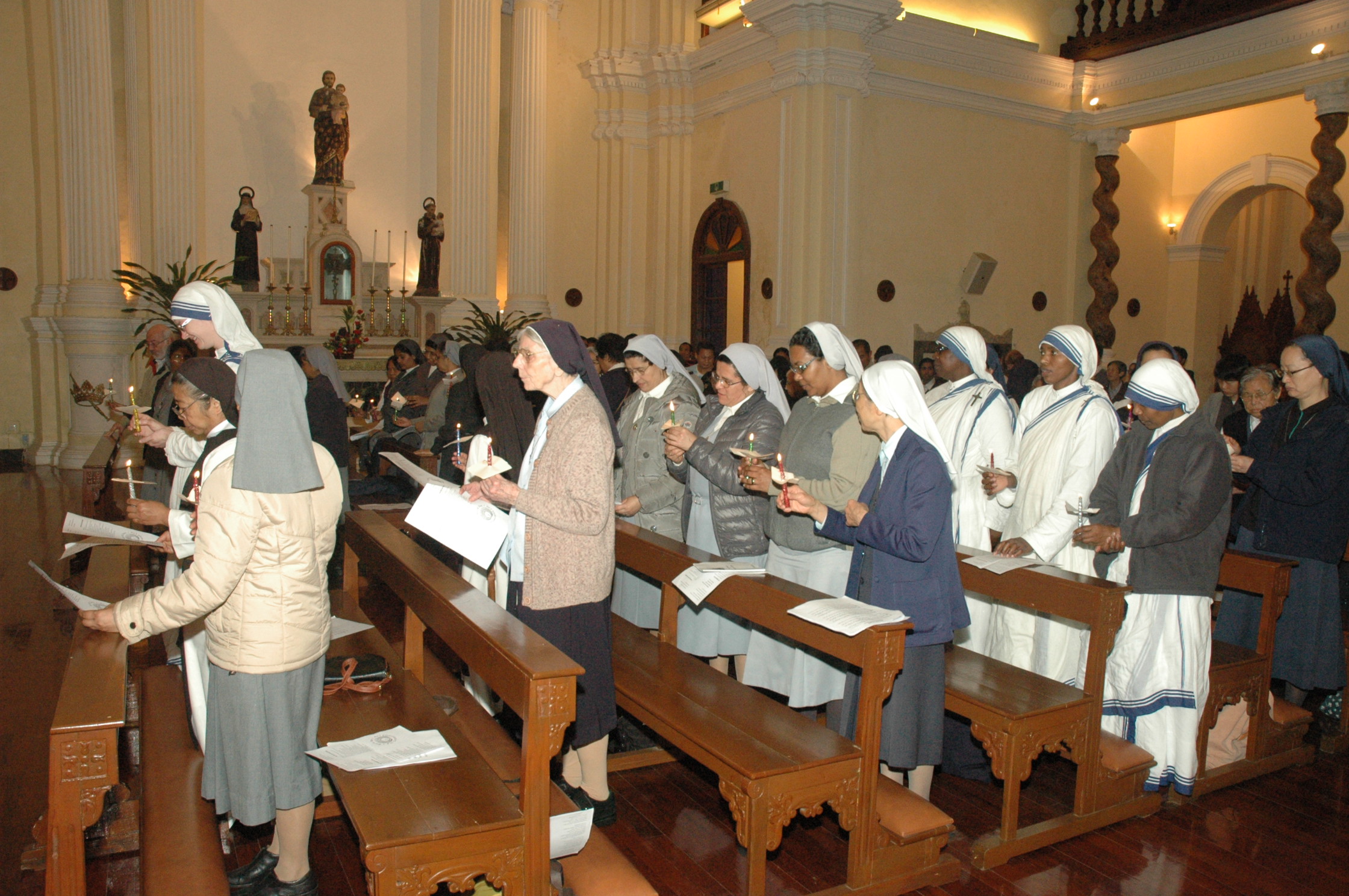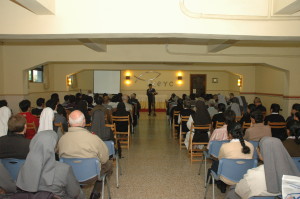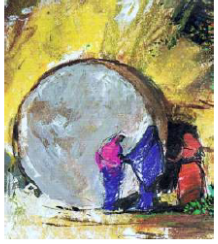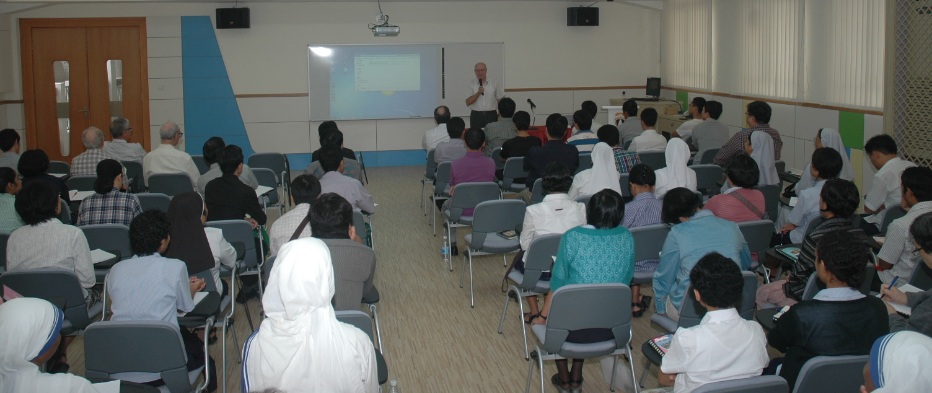
Course of Introduction to Christian Spirituality
Fr. Fausto Gomez OP
Faculty of Christian studies
University of Saint Joseph
Macau, March 2014

Fr. Fausto Gomez OP
Faculty of Christian studies
University of Saint Joseph
Macau, March 2014

24 February
BLESSED ASCENSION NICOL GOÑI
Virgin, Sister and Foundress
Greater China Region: Optional memoria
Blessed Ascensión of the Heart of Jesus, born Florentina Nicol Goñi in Tafalla, Navarra, Spain, she entered the Dominican Third Order Nuns in Huesca. She was a teacher and directress of the school adjacent to the convent. At 45, upon the invitation of the Dominican Bishop, the Servant of God, Ramón Zubieta Les, she traveled to Peru and pioneered the missionary work in the Amazon jungle, evangelizing the Amazonian tribes and elevating the status of women and children through education and social service. She helped found the Congregation of Dominican Missionary Sisters of the Most Holy Rosary, which she led with prudence and wisdom as its first general superior. In 1933 she led a group of sisters to make a foundation in China and cooperated in the foundation of the Congregation of the Dominican Third Order Sisters of Funing. In her last years she dedicated her soul and energy to consolidate her foundations, with prudence, abnegation and wisdom. All these activities were coupled with her failing health, which she bore with heroic patience. She died at the Congregation’s Motherhouse at Pamplona on 24 February 1940. She was beatified by Benedict XVI in 14 May, 2005.
From the Common of Virgins: For Women Religious, except the following.
THE OFFICE OF READINGS
Second Reading
From the Apostolic Letter «Mulieris Dignitatem» of Pope Blessed John Paul II, Pope.
(Apostolic Letter, «Mulieris Dignitatem», 15 August, 1988, no. 20)
They realize the personal value of their own femininity by becoming “a sincere gift” for God
On the basis of the Gospel, the meaning of virginity was developed and better understood as a vocation for women too, one in which their dignity, like that of the Virgin of Nazareth, finds confirmation. The Gospel puts forward the ideal of the consecration of the person, that is, the person’s exclusive dedication to God by virtue of the evangelical counsels: in particular, chastity, poverty and obedience. Their perfect incarnation is Jesus Christ himself. Whoever wishes to follow him in a radical way chooses to live according to these counsels. They are distinct from the commandments and show the Christian the radical way of the Gospel. From the very beginning of Christianity men and women have set out on this path, since the evangelical ideal is addressed to human beings without any distinction of sex.
In this wider context, virginity has to be considered also as a path for women, a path on which they realize their womanhood in a way different from marriage. In order to understand this path, it is necessary to refer once more to the fundamental idea of Christian anthropology. By freely choosing virginity, women confirm themselves as persons, as beings whom the Creator from the beginning has willed for their own sake. At the same time they realize the personal value of their own femininity by becoming “a sincere gift” for God who has revealed himself in Christ, a gift for Christ, the Redeemer of humanity and the Spouse of souls: a “spousal” gift. One cannot correctly understand virginity – a woman’s consecration in virginity – without referring to spousal love. It is through this kind of love that a person becomes a gift for the other..
Women, called from the very “beginning” to be loved and to love, in a vocation to virginity find Christ first of all as the Redeemer who “loved until the end” through his total gift of self; and they respond to this gift with a “sincere gift” of their whole lives. They thus give themselves to the divine Spouse, and this personal gift tends to union, which is properly spiritual in character. Through the Holy Spirit’s action a woman becomes “one spirit” with Christ the Spouse.
This is the evangelical ideal of virginity, in which both the dignity and the vocation of women are realized in a special way. In virginity thus understood the so-called radicalism of the Gospel finds expression: “Leave everything and follow Christ” (cf. Mt 19:27). This cannot be compared to remaining simply unmarried or single, because virginity is not restricted to a mere “no”, but contains a profound “yes” in the spousal order: the gift of self for love in a total and undivided manner.
Responsory
R. How great is your beauty, Virgin of Christ* you have been proved worthy of the reward given by the Lord, the crown of perpetual virginity.
V. Nothing could bring you to surrender virginity; nothing could separate you from the love of the Son of God.
R. * you have been proved worthy of the reward given by the Lord, the crown of perpetual virginity.
Alternative Second Reading
A reading from the Encyclical Letter «Redemptoris Missio» by Blessed John Paul II, Pope.
(Encyclical «Redemptoris Missio», 7 December, 1990, nn. 33-34.)
The missio ad gentes knows no boundaries
By virtue of Christ’s universal mandate, the missio ad gentes knows no boundaries. Still, it is possible to determine certain parameters within which that mission is exercised, in order to gain a real grasp of the situation.
Missionary activity has normally been defined in terms of specific territories. The Second Vatican Council acknowledged the territorial dimension of the missio ad gentes, a dimension which even today remains important for determining responsibilities, competencies and the geographical limits of missionary activity. Certainly, a universal mission implies a universal perspective. Indeed, the Church refuses to allow her missionary presence to be hindered by geographical boundaries or political barriers. But it is also true that missionary activity ad gentes, being different from the pastoral care of the faithful and the new evangelization of the non-practicing, is exercised within well-defined territories and groups of people.
The growth in the number of new churches in recent times should not deceive us. Within the territories entrusted to these churches – particularly in Asia, but also in Africa, Latin America and Oceania – there remain vast regions still to be evangelized. In many nations entire peoples and cultural areas of great importance have not yet been reached by the proclamation of the Gospel and the presence of the local church. Even in traditionally Christian countries there are regions that are under the special structures of the mission ad gentes, with groups and areas not yet evangelized. Thus, in these countries too there is a need not only for a new evangelization, but also, in some cases, for an initial evangelization.
Situations are not, however, the same everywhere. While acknowledging that statements about the missionary responsibility of the Church are not credible unless they are backed up by a serious commitment to a new evangelization in the traditionally Christian countries, it does not seem justified to regard as identical the situation of a people which has never known Jesus Christ and that of a people which has known him, accepted him and then rejected him, while continuing to live in a culture which in large part has absorbed gospel principles and values. These are two basically different situations with regard to the faith.
Thus the criterion of geography, although somewhat imprecise and always provisional, is still a valid indicator of the frontiers toward which missionary activity must be directed. There are countries and geographical and cultural areas which lack indigenous Christian communities. In other places, these communities are so small as not to be a clear sign of a Christian presence; or they lack the dynamism to evangelize their societies, or belong to a minority population not integrated into the dominant culture of the nation. Particularly in Asia, toward which the Church’s missio ad gentes ought to be chiefly directed, Christians are a small minority, even though sometimes there are significant numbers of converts and outstanding examples of Christian presence.
The rapid and profound transformations which characterize today’s world, especially in the southern hemisphere, are having a powerful effect on the overall missionary picture. Where before there were stable human and social situations, today everything is in flux. One thinks, for example, of urbanization and the massive growth of cities, especially where demographic pressure is greatest. In not a few countries, over half the population already lives in a few “megalopolises,” where human problems are often aggravated by the feeling of anonymity experienced by masses of people.
In the modern age, missionary activity has been carried out especially in isolated regions which are far from centers of civilization and which are hard to penetrate because of difficulties of communication, language or climate. Today the image of missio ad gentes is perhaps changing: efforts should be concentrated on the big cities, where new customs and styles of living arise together with new forms of culture and communication, which then influence the wider population. It is true that the “option for the neediest” means that we should not overlook the most abandoned and isolated human groups, but it is also true that individual or small groups cannot be evangelized if we neglect the centers where a new humanity, so to speak, is emerging, and where new models of development are taking shape. The future of the younger nations is being shaped in the cities.
Speaking of the future, we cannot forget the young, who in many countries comprise more than half the population. How do we bring the message of Christ to non-Christian young people who represent the future of entire continents? Clearly, the ordinary means of pastoral work are not sufficient: what are needed are associations, institutions, special centers and groups, and cultural and social initiatives for young people. This is a field where modern ecclesial movements have ample room for involvement.
Among the great changes taking place in the contemporary world, migration has produced a new phenomenon: non-Christians are becoming very numerous in traditionally Christian countries, creating fresh opportunities for contacts and cultural exchanges, and calling the Church to hospitality, dialogue, assistance and, in a word, fraternity. Among migrants, refugees occupy a very special place and deserve the greatest attention. Today there are many millions of refugees in the world and their number is constantly increasing. They have fled from conditions of political oppression and inhuman misery, from famine and drought of catastrophic proportions. The Church must make them part of her overall apostolic concern.
Finally, we may mention the situations of poverty – often on an intolerable scale – which have been created in not a few countries, and which are often the cause of mass migration. The community of believers in Christ is challenged by these inhuman situations: the proclamation of Christ and the kingdom of God must become the means for restoring the human dignity of these people.
Responsory Mk 16:15-16; Jn 3:5
R. Go out to the whole world; proclaim the Good News to all creation: * He who believes and is baptized will be saved.
V. No one can enter the kingdom of God without being born from water and Spirit.
R. * He who believes and is baptized will be saved.
Concluding Prayer
Lord you bestowed upon your virgin, Blessed Ascension Nicol countless apostolic virtues and inspired her to offer her life to serve and educate the poor, the marginalized, the women and the weak; may we cherish what she treasured in life and put her teachings and counsels into practice. (We make our prayer) through our Lord. (Through Christ our Lord.)
Or
God, the Father of mercy, you called Blessed Ascension to serve you with generosity in the most needy: allow us, through her intercession to discover the treasures of your love and to share them with all humanity. (We make our prayer) through our Lord. (Through Christ our Lord.)
By Fr. Jarvis Sy.

20 February
BLESSED FRANCISCO MARTO
AND BLESSED JACINTA MARTO
The Little Shepherds of Fatima
Francisco Marto (June 11, 1908–April 4, 1919) and his sister Jacinta Marto (March 11, 1910–February 20, 1920), together with their cousin, Lúcia dos Santos (1907–2005) were the shepherd children from Aljustrel near Fátima, Portugal who reported to have witnessed three apparitions of an angel in 1916 and several apparitions of the Blessed Virgin Mary in 1917.
Following the Marian apparitions, while their fundamental personalities remained the same, there was a very drastic transformation in the lives with regards to their faith and piety. Heeding the call of the Virgin for atonement and reparation for sins, they began to spend time in prayer, and make penances and stringent self –mortification for the conversion of sinners “to console Jesus for the sins of the world”.
The siblings fell victims of the great influenza epidemic (known in history as the “Spanish Fluâ€) which swept through Europe in 1918. Both lingered for many months. Francisco declined hospital treatment and died peacefully at home on April 4, 1919. Meanwhile Jacinta had to endure greater suffering as her health worsened and developed complications which she bore with the most heroic of patience and courage. She died alone as she had prophesized, in far away Lisboa. Both siblings were beatified by Blessed John Paul II on 13 May, 2000 which coincided with the publication of the “third Secret†of Fatima. The liturgical memory is fixed on the date of the glorious passage of Bl. Jacinta to the next life.
From the Common of Saints, except the following.
THE OFFICE OF READINGS
Second Reading
The Homily of Blessed John Paul II on the occasion of the beatification of Francisco and Jacinto Marto, (Fátima, 13 May, 2000. Nn. 1-4)
They see a light shining from her maternal hands which penetrates them inwardly,
so that they feel immersed in God.
“Father, … to you I offer praise; for what you have hidden from the learned and the clever you have revealed to the merest children” (Mt 11: 25). With these words, dear brothers and sisters, Jesus praises the heavenly Father for his designs; he knows that no one can come to him unless he is drawn by the Father (cf. Jn 6: 44); therefore he praises him for his plan and embraces it as a son: “Yes, Father, for such was your gracious will” (Mt 11: 26). You were pleased to reveal the kingdom to the merest children.
Later Francisco, one of the three privileged children, exclaimed: “We were burning in that light which is God and we were not consumed. What is God like? It is impossible to say. In fact we will never be able to tell people”. God: a light that burns without consuming. Moses had the same experience when he saw God in the burning bush; he heard God say that he was concerned about the slavery of his people and had decided to deliver them through him: “I will be with you” (cf. Ex 3: 2-12). Those who welcome this presence become the dwelling-place and, consequently, a “burning bush” of the Most High.
What most impressed and entirely absorbed Blessed Francisco was God in that immense light which penetrated the inmost depths of the three children. But God told only Francisco “how sad” he was, as he said. One night his father heard him sobbing and asked him why he was crying; his son answered: “I was thinking of Jesus who is so sad because of the sins that are committed against him”. He was motivated by one desire – so expressive of how children think – “to console Jesus and make him happy”.
A transformation takes place in his life, one we could call radical: a transformation certainly uncommon for children of his age. He devotes himself to an intense spiritual life, expressed in assiduous and fervent prayer, and attains a true form of mystical union with the Lord. This spurs him to a progressive purification of the spirit through the renunciation of his own pleasures and even of innocent childhood games.
Francisco bore without complaining the great sufferings caused by the illness from which he died. It all seemed to him so little to console Jesus: he died with a smile on his lips. Little Francisco had a great desire to atone for the offences of sinners by striving to be good and by offering his sacrifices and prayers.
The life of Jacinta, his younger sister by almost two years, was motivated by these same sentiments. Little Jacinta felt and personally experienced Our Lady’s anguish, offering herself heroically as a victim for sinners. One day, when she and Francisco had already contracted the illness that forced them to bed, the Virgin Mary came to visit them at home, as the little one recounts: “Our Lady came to see us and said that soon she would come and take Francisco to heaven. And she asked me if I still wanted to convert more sinners. I told her yes”. And when the time came for Francisco to leave, the little girl tells him: “Give my greetings to Our Lord and to Our Lady and tell them that I am enduring everything they want for the conversion of sinners”. Jacinta had been so deeply moved by the vision of hell during the apparition of 13 July that no mortification or penance seemed too great to save sinners.
“Father, to you I offer praise, for you have revealed these things to the merest children”. Today the Church wishes to put on the candelabrum these two candles which God lit to illumine humanity in its dark and anxious hours. May they shine on the path of this immense multitude of pilgrims… may Francisco and Jacinta be a friendly light that illumines all Portugal.
Responsory 1 Cor 7: 29, 30; 2: 12.
R. Our time is growing shot. Those who enjoy life should live as though there were nothing to enjoy, and those who deal with worldly things should not become engrossed in them. * I say this because the world as we know it is passing away.
V. It is not the spirit of the world which we have received.
R. * I say this because the world as we know it is passing away.
Concluding Prayer
O God who granted to Blessed Francisco and Blessed Jacinta the two little Shepherds the grace to become little burning bushes on fire with love for God and the Church; Grant that we, too, may burn with the same love and, with them, all meet together again in Heaven around Our Lady in adoration of the Blessed Trinity. (We make our prayer) through our Lord. (Through Christ our Lord.)
By Fr. Jarvis Sy.

Religious men and women working in Macau for the Kingdom gathered together on February 2, 2014, to celebrate joyfully and prayerfully the Day of Consecrated Life, which is celebrated throughout the world on this day, the Presentation of our Lord.
The meeting started at 5:30 p.m. at the seminary with a talk by Fr. John Ledesma, SDB, on Our Spirituality. Hereafter, we offer a summary of the well-received speech of Fr. Ledesma. The speaker began by saying: “We need to -Study it, Speak it , Pray it, and Live it out.â€
Fr. Ledesma spoke of five dangers: danger of exaggerations; speaking the language of the world and pursuing the values of the world; not following the challenge of every spirituality  that is, creative fidelity; working for God but not doing God’s work, and following a Christ without the cross. He developed the first tow dangers.
Regarding the first danger, the danger of exaggerations, the speaker said that we live in a culture of consumerism and materialism; of violence, terrorism and death; of advanced technology, communication and science; and a culture of pluralism and secularization. Religious life is a life of “challenging/healthy tensionsâ€: formal prayer – direct apostolate; individual uniqueness – community life.
Vow poverty: need to be detached, simple, austere – access to material goods; need to use them. Vow of chastity: need to be detached, celibate) – need to enter into people’s lives and be “personal†and compassionate. Vow of obedience: need to be detached; go where we are sent – need to discern; use our sense of giftedness and talents.
Regarding the second danger, or the language of the world and pursuing the values of the world, Fr. Ledesma he opposed the language of the world focused on profit, productivity, investments, promotions, domination…; and the language of spirituality, which is centered on vocation, mission, Gospel values, the Beatitudes, sacrifice, compassion, the least, the lost and the last, the cross…
After the reflection, the sisters and the brothers went to the Chapel of Saint Joseph Seminary for the solemn celebration of the Holy Eucharist, which was presided by Bishop Jose Lai, and concelebrated by 15 priests. Over one 100 religious men and women participated in the Mass. In his homily, the bishop echoed the discourse of Pope Francis to Major Religious Superiors last November at the Vatican. He also underlined the fact that Macao is ‘mission territory’ and needs the commitment of all religious men and wmen.
There were a couple of testimonies after communion as well as presentation by Bishop Lai about his plan to ask religious in Macao to organize language courses in Latin and Latin languages with a double aim: to help the people in Macao and also to let people know more about religious life and their different charisms.
The celebration of the Eucharist was followed by a dinner – a pleasant and tasteful agape with plenty of food and laughter and everybody having a good time (AR).


Saint Dominic’s Center of Studies officially began its series of formation courses for Christian and Religious Life on Saturday afternoon (9 Nov 2013) at Saint Paul’s School, Macau.
The two new courses for school year 2013-2014 started with some welcoming remarks from Fr. Javier González, Prior Provincial. Then there was an introduction to the Center of Studies by Fr. Edmond Eh, Moderator. Fr. José Luis de Miguel, Assistant master of Students delivered the introduction to his course: “Liturgical Symbols and Psalms.†The topic for the day was “The Way as Symbol.†Fr. Jarvis Sy, Master of Students, next delivered the introduction to his course: “Evangelical Counsels in the 21st Century.â€
After the introductory lectures, the students and other participants were invited to choose one of the two courses and to register. The session ended with a concluding prayer in the school chapel. (EE)